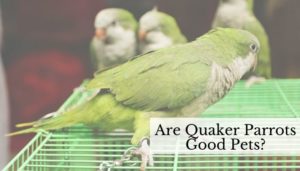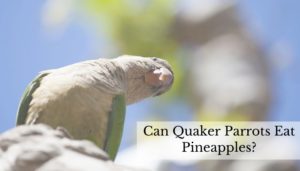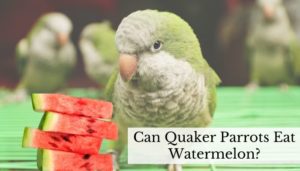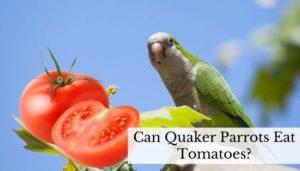This article will cover everything you need to know about female Quaker parrot behavior, their personality, and the differences from their male counterparts.
Quaker parrots, otherwise known as Monk parakeets, are easily one of the most popular pet birds in South America, thanks to their loving personalities and comical nature.
However, if you’re thinking about taking one home, it’s essential to learn everything you need to know about them to meet their needs.
This is especially the case for female Quaker parrots, as they are a bit more delicate and have their own specific needs. Then there’s the hormonal behavior and mating displays of these parrots, which can easily overwhelm any beginner bird-keeper.
So, before you take one home, here’s everything you need to know about female Quaker parrot behavior.
Female Quaker Parrot Behavior and Personality
In general, Quaker parrots are very confident, social, and loud. In fact, Quaker parrots get their name from their quaking and shaking behavior, which they are prone to do very often. They’re also known to “talk,” and can develop a significant vocabulary.
When it comes to female Quaker parrots, however, you’ll find that they are calmer and cuddlier compared to their male counterparts. Whilst male Quaker parrots tend to be more social and outgoing, female Quaker parrots are usually more laid back and docile.
Of course, this will depend on how much attention you give them, as a female Quaker parrot that has bonded with you will be very affectionate, perhaps even more than males.
The truth is, while female Quaker parrots are a bit calmer, the difference in behavior between male and female Quaker parrots is minimal.
That said, this minimal difference also means that when reared right, taking care of a female Quaker parrot will be just as rewarding as looking after a male Quaker parrot. They will also “talk” just as much as male parrots, especially if it’s already attached and has learned a few words from its owner.
So, male or female Quaker parrot, make sure to prepare yourself when giving one a home, because they will make their presence known.
Additional reading: Are Quaker Parrots Good Pets?
Female Quaker Parrot Mating Behavior
One of the easiest ways to determine the difference between a male and female Quaker parrot is during the mating season, where they undergo hormonal changes.
During this period (usually between October and January), male Quaker parrots tend to exhibit these traits:
- Aggressive
- Territorial
- Bitey
These are all normal, as male Quaker parrots do these to exhibit sexual frustration. You might also hear its mating calls, although it’s never loud enough to bother the neighbors. By comparison, female Quaker Parrots tend to be quieter, although they will have their share of screams and bird noises.
During mating season, a female Quaker parrot is more inclined to lay eggs. In case you don’t know, female Quakers can still lay eggs without the male. Of course, these eggs will never hatch, and she will move on from them not long after.
Another hormonal behavior that female Quaker parrots show is increased vocalization, increased chewing of paper toys, hormonal feather plucking, and even possessiveness of their favorite human.
Should you want to discourage egg-laying for your female Quaker parrot, here are some things you can do:
- Remove dark spaces in the cage – All parrots look for a dark and enclosed space to lay eggs, so removing any places like that will help stop her from laying. Of course, there’s a possibility of your bird making the dark space herself, so it’s best to watch her and prevent any instances.
- Make her sleep early – Another strategy is to put her to bed early, as long days and short nights are often an environmental cue for them to lay eggs. To do this, just put her in complete darkness, and she will believe the days are still short.
- Give her fiber-rich food – Unlike wild parrots, domesticated ones often always have easy access to fruit, giving them extra energy that they can use for breeding come mating season. As such, it’s a good idea to instead feed her fiber-rich food, since this does two things:
- Stops her from overeating
- Prevents extra energy that would be channeled into breeding behavior
- Ease up on affection – As mentioned above, female quaker parrots tend to be possessive of their humans during the mating period. As such, it’s a good idea to limit petting and showing affection to your pet so it doesn’t take this as a trigger for breeding behavior.
- Mimic winter – Lastly, you can mimic winter by lowering the temperature of your bird’s home. Doing so will make it believe that it’s not the mating season yet, so it won’t release the necessary hormones.
Additional reading: Differences Between Male and Female Crimson Rosella
What’s the Difference Between Male and Female Quaker Parrots
While many birds have distinct differences between males and females, this is unfortunately not the case for Quaker parrots.
Quaker parrots are what’s known as “monomorphic birds,” meaning that both males and females look very identical. There are, however, some slight differences.
For example, it’s said that females tend to be about 20% smaller and have duller colors than the male. That said, it can be hard to tell the difference based on that alone, so you may have to ask a trusted veterinarian to do a test for you.
Other Things You Need to Know
- Quaker Parrots are the only nesting parrot species – That’s right, out of all the parrot species, Quaker parrots are the only official “colony nesters.” In particular, female Quaker parrots have the bigger responsibility of maintaining the nest, while the male goes out to look for food.
- Quaker Parrots are monogamous – Quaker parrots only mate once and bond for life. That said, any female Quaker parrot showered by affection from its owner will likely be possessive of its owner, even seeing it as her mate.
Final Thoughts
All in all, the behavior of a female Quaker Parrot tends to be similar to other female parrot species of its size.
They are very affectionate, loud, and love to build bonds with people (or birds) that they are close to. They’re also quite hard to distinguish from their male counterparts, and overall show mostly similar personalities.
Needless to say, knowing these things and remembering them is key to becoming a more responsible bird-owner.







